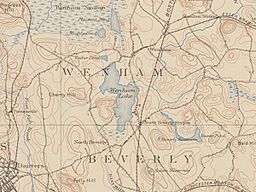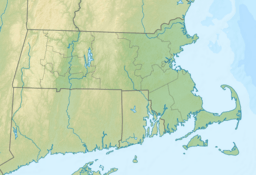Wenham Lake facts for kids
Quick facts for kids Wenham Lake |
|
|---|---|
 |
|

Map of Wenham Lake, 1897, showing the now commuter rail.
|
|
| Location | Beverly / Wenham, Massachusetts, U.S. |
| Coordinates | 42°35′34.85″N 70°53′35.72″W / 42.5930139°N 70.8932556°W |
| Basin countries | United States |
| Surface elevation | 32 ft (9.8 m) |
Wenham Lake is a beautiful 224-acre lake located in the towns of Wenham and Beverly in Essex County, Massachusetts. It gets its water from underground sources and from several streams. Long ago, in the 1800s, this lake was famous for its ice, which was even sent all the way to Britain! Today, Wenham Lake is a very important reservoir (a place that stores water) for the cities of Salem and Beverly.
Contents
How Wenham Lake Gets Its Water
Wenham Lake gets its water from two main places. First, it gets water from the water table, which is the underground level where the ground is full of water. Second, it gets water from nearby streams.
These streams flow into the lake from places like Beaver Pond, Norwood Pond, and Longham Reservoir. They travel through fields and woods to the east of the lake. These streams are carefully controlled. Water also flows into the lake from the west, near Beverly Regional Airport. Here, water enters through deep channels in areas shaped by ancient glaciers. These areas are covered with hemlock and pine trees.
The History of Wenham Lake
Wenham Lake is on the traditional land of the Agawam people. The Agawam tribe used to own the eastern part of what is now Essex County, Massachusetts.
In the 1600s, the Agawam people gave these lands to the English settlers. This was done through a special agreement called a quitclaim deed. Chief Masconomet signed this deed, giving the land to John Winthrop the Younger. This agreement was part of a plan for the Agawam people, whose numbers had dropped due to disease, to join with the English colonists from Charlestown, Massachusetts.
The lake was first called "Great Pond" in the old records of Salem, Massachusetts.
How Wenham Lake Got Its Name
In 1638, Hugh Peters, a Puritan minister from the First Church of Salem, gave a sermon by the lake. He spoke about "Enon, near Salem, because there was much water there," which is a Bible verse from John 3:23. Because of this sermon, a small settlement nearby was named "Enon." There's even a stone with a plaque marking the spot where he gave his sermon.
"Enon" was officially recognized by the General Court of Massachusetts on November 5, 1639. Then, on May 10, 1643, Enon became an official town and was renamed Wenham. That's when the lake officially became known as Wenham Lake.
Wenham Lake in Books and Poems
Many writers have been inspired by Wenham Lake:
- In 1846, Benjamin Barker wrote a story called Mornilva, or the outlaw of the forest: a romance of Lake Wenham. He described the lake's "clear, calm and placid waters" and its "beautiful and picturesque hills."
- In 1877, the Quaker poet John Greenleaf Whittier wrote a poem called "The Witch of Wenham". This poem was set right on the shores of Wenham Lake.
- In the early 1900s, John Charles Phillips, an ornithologist (someone who studies birds) and hunter, wrote a book called "Wenham Great Pond." It was about his ten years spent at Wenham Lake.
Past Uses of Wenham Lake
Wenham Lake has been used for different things throughout history.
Fishing for Alewife
In the early days of the colonies, catching alewife fish was a big part of Wenham's local economy. Alewives are a type of fish that swim from the ocean into freshwater to lay their eggs. Wenham Lake was a major place for them to do this. The fish would enter the lake through an outlet that flowed into the Miles River, which then joined the Ipswich River.
People continued to catch alewife until the 1800s. At that time, dams were built on the Ipswich River and other streams. These dams blocked the fish from reaching the lake, and the alewife fishing trade ended. The lake's water was also used to power a mill through a dam. Today, the area where the outlet was is covered by a road (Route 1A) and part of the Lakeview Golf Course. All the ponds in the area are now protected because they are part of the drinking water supply.
Exporting Ice from the Lake
The business of shipping ice across the Atlantic Ocean began in the 1840s. In 1844, the first shipment of ice from Wenham Lake arrived in England. The ice from Wenham Lake became famous all over the world. People in Britain especially loved it because it was so pure. Some even say that Queen Victoria herself used ice from Wenham Lake!
Wenham Lake ice was so popular that some ice sellers in Norway even renamed their own Lake Oppegård to "Wenham Lake" for a short time. This way, they could pretend their ice was from the famous Wenham Lake in Massachusetts.
The Landers family, who owned the first ice house on the lake, built a special railroad track just for transporting ice. One of the people who helped build this railroad was Grenville M. Dodge. He later became a Major General in the Union Army during the Civil War and was very important in building the first transcontinental railroad across the United States in 1869. The old railroad track from the lake later became part of the Beverly-Newburyport commuter rail line. You can still see where the railroad track used to be behind the fifth hole of the Lakeview Golf Course.
Harvesting the ice was a big job. It took about 100 men and 30 to 40 horses! They waited for the lake to freeze with at least a foot of clear, dark ice. First, they would sweep off any snow. If there was snow-ice (ice mixed with snow), they would scrape it off using horse-drawn vehicles. Then, a horse-drawn tool called a "marker" would score the ice. It made a grid of 21-inch squares, about 2-3 inches deep, over a large area of the lake.
Men with saws would cut along one line, and then men with ice spades would break the blocks free. Another group of workers used ice hooks to pull the ice blocks up ramps onto platforms. Once a platform was full, the blocks were slid onto sleds. These sleds took the ice to ice houses on the shore. An ice house was built with thick pine walls filled with sawdust, about 2 feet (61 cm) thick, to keep the ice cold.
The ice blocks were packed in sawdust for their journey. They were loaded onto a special train car and taken directly to a dock in Boston. The ice arrived in Boston within an hour of being cut, without melting at all! However, when it was shipped to Britain by boat, about a third of the ice would melt during the trip.
The ice business continued until at least 1912. That year, John C. Kelleher started the Beverly Ice Company to harvest the lake's ice. But the ice trade from Wenham Lake ended soon after that.
Modern Uses of Wenham Lake
Today, Wenham Lake is still very important, but for different reasons.
Water Supply
Wenham Lake was officially set aside as a water reservoir for the Salem and Beverly Water Supply Board, which was created in 1913. This means the lake's water is used to provide drinking water to the cities of Salem and Beverly. Wenham Lake is now a key part of the local water system.
Recreation
The lake and its shores are not open to the general public. There are high fences and cameras at the southern end to keep people out. Signs around the lake warn people not to trespass. The evergreen trees on the hills around the lake are privately owned.
Because the lake is kept so isolated, many migratory birds that used to only be seen in Wenham Swamp (about a mile north) now rest and feed in larger numbers on the lake. Even though it's a private area, many local fishermen still think it's one of the best places to fish in northern Massachusetts.
Environment of Wenham Lake
In 2001, a group called the Wenham Lake Watershed Association found a lot of pollution in the lake. There were huge amounts of fly ash (a fine powder left over from burning coal) that had been there since the 1950s and 1960s. These deposits were about 7,800 cubic yards in total and were more than 3 feet deep in some spots.
This fly ash came from a nearby place called the Vitale dump. This dump was an old gravel and sand quarry that had illegally stored waste from coal burned at the Salem Harbor Power Generating Station. In the years since, the lake has been cleaned by dredging (removing the unwanted material from the bottom). The lake's health is still watched carefully to make sure it stays clean.



